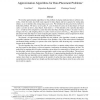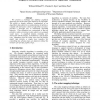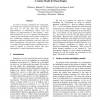SOCIALCOM
2010
14 years 5 months ago
2010
Abstract--As the information flowing around in social networking systems is mainly related or can be attributed to their users, controlling access to such information by individual...
SIAMCOMP
2008
14 years 7 months ago
2008
We develop approximation algorithms for the problem of placing replicated data in arbitrary networks, where the nodes may both issue requests for data objects and have capacity fo...
DMSN
2010
ACM
14 years 8 months ago
2010
ACM
In sparse and intermittently connected Mobile Sensor Networks (MSNs), the base station cannot easily get the data objects acquired by the mobile sensors in the field. When users q...
CIDR
2007
14 years 8 months ago
2007
In this paper, we present a free-and-easy data publishing and sharing system based on folksonomy. The system accepts data objects described with user-created metadata, called data...
NSDI
2007
14 years 9 months ago
2007
Many contemporary approaches for speeding up large file transfers attempt to download chunks of a data object from multiple sources. Systems such as BitTorrent quickly locate sou...
ICPR
2010
IEEE
14 years 10 months ago
2010
IEEE
The paper introduces a framework for clustering data objects in a similarity-based context. The aim is to cluster objects into a given number of classes without imposing a hard pa...
DEXAW
2007
IEEE
14 years 11 months ago
2007
IEEE
Peers and data objects in the Hybrid Overlay Network (HON) are organized in a ndimensional feature space. As the dimensionality increases, peers and data objects become sparse and ...
VISUALIZATION
1992
IEEE
14 years 11 months ago
1992
IEEE
algorithms as networks of modules. The data flow architecture is popular because of the flexibility of mixing calculation modules with display modules, and because of its easy grap...
VISUALIZATION
1994
IEEE
14 years 11 months ago
1994
IEEE
We will try to address the need for a formal foundation for visualization by taking an analytic approach to defining D. Since an arbitrary function D: U V will not produce display...
SSD
1999
Springer
14 years 11 months ago
1999
Springer
This work is a contribution to the developing literature on multi-resolution data models. It considers operations for model-oriented generalization in the case where the underlying...






